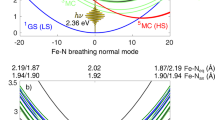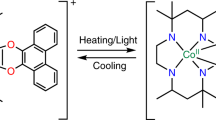Abstract
Photoinduced charge-transfer is an important process in nature and technology and is responsible for the emergence of exotic functionalities, such as magnetic order for cyanide-bridged bimetallic coordination networks. Despite its broad interest and intensive developments in chemistry and material sciences, the atomic-scale description of the initial photoinduced process, which couples intermetallic charge-transfer and spin transition, has been debated for decades; it has been beyond reach due to its extreme speed. Here we study this process in a prototype cyanide-bridged CoFe system by femtosecond X-ray and optical absorption spectroscopies, enabling the disentanglement of ultrafast electronic and structural dynamics. Our results demonstrate that it is the spin transition that occurs first on the Co site within ~50 fs, and it is this that drives the subsequent Fe-to-Co charge-transfer within ~200 fs. This study represents a step towards understanding and controlling charge-transfer-based functions using light.

This is a preview of subscription content, access via your institution
Access options
Access Nature and 54 other Nature Portfolio journals
Get Nature+, our best-value online-access subscription
$29.99 / 30 days
cancel any time
Subscribe to this journal
Receive 12 print issues and online access
$259.00 per year
only $21.58 per issue
Buy this article
- Purchase on Springer Link
- Instant access to full article PDF
Prices may be subject to local taxes which are calculated during checkout



Similar content being viewed by others
Data availability
The datasets generated and analysed during the current study are available in the HAL repository at https://hal.archives-ouvertes.fr/hal-02996531 or from the authors upon request.
References
McCusker, J. K. Electronic structure in the transition metal block and its implications for light harvesting. Science 363, 484–488 (2019).
Canton, S. E. et al. Visualizing the non-equilibrium dynamics of photoinduced intramolecular electron transfer with femtosecond X-ray pulses. Nat. Commun. 6, 6359 (2015).
Sato, O., Iyoda, T., Fujishima, A. & Hashimoto, K. Photoinduced magnetization of a cobalt-iron cyanide. Science 272, 704–705 (1996).
Ohkoshi, S. & Tokoro, H. Photomagnetism in cyano-bridged bimetal assemblies. Acc. Chem. Res. 45, 1749–1758 (2012).
Ferlay, S., Mallah, T., Ouahes, R., Veillet, P. & Verdaguer, M. A room-temperature organometallic magnet based on Prussian blue. Nature 378, 701–703 (1995).
Liedy, F. et al. Vibrational coherences in manganese single-molecule magnets after ultrafast photoexcitation. Nat. Chem. 12, 452–458 (2020).
Collet, E. et al. Laser-induced ferroelectric structural order in an organic charge-transfer crystal. Science 300, 612–615 (2003).
Chollet, M. et al. Gigantic photoresponse in 1/4-filled-band organic salt (EDO-TTF)2PF6. Science 307, 86–89 (2005).
Cartier dit Moulin, C. et al. Photoinduced ferrimagnetic systems in Prussian blue analogues CIxCo4[Fe(CN)6]y (CI = alkali cation). 2. X-ray absorption spectroscopy of the metastable state. J. Am. Chem. Soc. 122, 6653–6658 (2000).
Risset, O. N. et al. Light-induced changes in magnetism in a coordination polymer heterostructure Rb0.24Co[Fe(CN)6]0.74@K0.10Co[Cr(CN)6]0.70·nH2O and the role of the shell thickness on the properties of both core and shell. J. Am. Chem. Soc. 136, 15660–15669 (2014).
Aguila, D., Prado, Y., Koumousi, E. S., Mathoniere, C. & Clerac, R. Switchable Fe/Co Prussian blue networks and molecular analogues. Chem. Soc. Rev. 45, 203–224 (2016).
Shimamoto, N., Ohkoshi, S., Sato, O. & Hashimoto, K. Control of charge-transfer-induced spin transition temperature on cobalt−iron Prussian blue analogues. Inorg. Chem. 41, 678–684 (2002).
Cafun, J. D. et al. Room-temperature photoinduced electron transfer in a Prussian blue analogue under hydrostatic pressure. Angew. Chem. Int. Ed. 51, 9146–9148 (2012).
Verdaguer, M. et al. Molecules to build solids: high TC molecule-based magnets by design and recent revival of cyano complexes chemistry. Coord. Chem. Rev. 190–192, 1023–1047 (1999).
Koumousi, E. S. et al. Metal-to-metal electron transfer in Co/Fe Prussian blue molecular analogues: the ultimate miniaturization. J. Am. Chem. Soc. 136, 15461–15464 (2014).
Mercurol, J. et al. [FeIILSCoIIILS]2 ⇔ [FeIIILSCoIIHS]2 photoinduced conversion in a cyanide-bridged heterobimetallic molecular square. Chem. Commun. 46, 8995–8997 (2010).
Miyamoto, Y. et al. Photo-induced magnetization and first-principles calculations of a two-dimensional cyanide-bridged Co–W bimetal assembly. Dalton Trans. 45, 19249–19256 (2016).
Asahara, A. et al. Ultrafast dynamics of reversible photoinduced phase transitions in rubidium manganese hexacyanoferrate investigated by midinfrared CN vibration spectroscopy. Phys. Rev. B 86, 195138 (2012).
Moritomo, Y. et al. Photoinduced phase transition into a hidden phase in cobalt hexacyanoferrate as investigated by time-resolved X-ray absorption fine structure. J. Phys. Soc. Jpn. 82, 033601 (2013).
Johansson, J. O. et al. Directly probing spin dynamics in a molecular magnet with femtosecond time-resolution. Chem. Sci. 7, 7061–7067 (2016).
van Veenendaal, M. Ultrafast intersystem crossings in Fe-Co Prussian blue analogues. Sci. Rep. 7, 6672 (2017).
Watanabe, S. et al. Intra- and inter-atomic optical transitions of Fe, Co, and Ni ferrocyanides studied using first-principles many-electron calculations. J. Appl. Phys. 119, 235102 (2016).
Verdaguer, M. Molecular electronics emerges from molecular magnetism. Science 272, 698–699 (1996).
Chergui, M. & Collet, E. Photoinduced structural dynamics of molecular systems mapped by time-resolved X-ray methods. Chem. Rev. 117, 11025–11065 (2017).
Lemke, H. T. et al. Coherent structural trapping through wave packet dispersion during photoinduced spin state switching. Nat. Commun. 8, 15342 (2017).
Trinh, L. et al. Photoswitchable 11 nm CsCoFe Prussian blue analogue nanocrystals with high relaxation temperature. Inorg. Chem. 59, 13153–13161 (2020).
Zerdane, S. et al. Probing transient photoinduced charge transfer in Prussian blue analogues with time-resolved XANES and optical spectroscopy. Eur. J. Inorg. Chem. 2018, 272–277 (2018).
Bordage, A. & Bleuzen, A. Influence of the number of alkali cation on the photo-induced CoIIIFeII ↔ CoIIFeIII charge transfer in Csx CoFe PBAs – a Co K-edge XANES study. Radiat. Phys. Chem. 175, 108143 (2020).
Chollet, M. et al. The X-ray pump-probe instrument at the Linac Coherent Light Source. J. Synchrotron Radiat. 22, 503–507 (2015).
Harmand, M. et al. Achieving few-femtosecond time-sorting at hard X-ray free-electron lasers. Nat. Photon. 7, 215–218 (2013).
Zerdane, S. et al. Comparison of structural dynamics and coherence of d–d and MLCT light-induced spin state trapping. Chem. Sci. 8, 4978–4986 (2017).
Frisch, M. J. et al. Gaussian 09 (Gaussian, Inc., 2016).
Ohkoshi, S. I. et al. Cesium ion detection by terahertz light. Sci. Rep. 7, 8088 (2017).
Zerdane, S., Cammarata, M., Iasco, O., Boillot, M. L. & Collet, E. Photoselective MLCT to d-d pathways for light-induced excited spin state trapping. J. Chem. Phys. 151, 171101 (2019).
Kawamoto, T. & Abe, S. Mechanism of reversible photo-induced magnetization in Prussian blue analogues. Phase Transit. 74, 209–233 (2006).
Acknowledgements
E.C. and M.C. acknowledge the support of Rennes Métropole, ANR (ANR-13-BS04-0002 FEMTOMAT, ANR-19-CE30-0004 ELECTROPHONE, ANR-19-CE29-0018 MULTICROSS and ANR-15-CE32-0004 Bio-XFEL), Centre National de la Recherche Scientifique (CNRS, PEPS SASLELX), Fonds Européen de Développement Régional (FEDER) and Région Bretagne (ARED 8925/XFELMAT). S.Z, L.C., T.M. and S.F.M. acknowledge the support of ANR (ANR-13-BS04-0002 FEMTOMAT). T.M. thanks the IUF (Institut Universitaire de France) for financial support. M.C., L.B., M.L., C.E. and M.T. acknowledge the support of European Union Horizon2020 under the Marie Skłodowska-Curie Project ‘X-Probe’ grant no. 637295. We thank A. Bleuzen for sharing the published XANES data used in Supplementary Fig. 7. Use of the Linac Coherent Light Source, SLAC National Accelerator Laboratory, is supported by the US Department of Energy, Office of Science, Office of Basic Energy Sciences under contract no. DE-AC02-76SF00515.
Author information
Authors and Affiliations
Contributions
E.C. and M.C., in collaboration with T.M. and S.F.M., conceived the project. S.M., L.C. and T.M. synthesized and characterized the CoFe sample. M.C., S.Z., L.B., G.A., C.E., M.T., M.L., R.A.M., J.M.G., S.S. and E.C. performed the femtosecond XANES experiment. S.Z. and G.A. performed the optical study. S.Z., M.C. and E.C. analysed the data. S.F.M. performed the DFT and TD-DFT calculations. E.C. and M.C. set the physical picture for interpreting the data. E.C. and M.C. wrote the paper. All authors contributed to discussions and gave comments on the manuscript.
Corresponding authors
Ethics declarations
Competing interests
The authors declare no competing interests.
Additional information
Peer review information Nature Chemistry thanks Michael Odelius and the other, anonymous, reviewer(s) for their contribution to the peer review of this work.
Publisher’s note Springer Nature remains neutral with regard to jurisdictional claims in published maps and institutional affiliations.
Supplementary information
Supplementary Information
Supplementary Figs. 1–10, Discussion and Table 1.
Supplementary Video 1
Torsion mode at 1.62 THz for the (CN)5–Coii–N–C–Feiii–(CN)5 state.
Supplementary Video 2
Torsion mode at 1.44 THz for the (CN)5–Coii–N–C–Feiii–(CN)5 state.
Supplementary Video 3
Torsion mode at 1.85 THz for the (CN)5–Coiii–N–C–Feii–(CN)5 state.
Supplementary Video 4
Torsion mode at 1.56 THz for the Co2iiiFe2ii square.
Supplementary Video 5
Breathing mode at 11.2 THz for the (CN)5–Coii–N–C–Feiii–(CN)5 state.
Rights and permissions
About this article
Cite this article
Cammarata, M., Zerdane, S., Balducci, L. et al. Charge transfer driven by ultrafast spin transition in a CoFe Prussian blue analogue. Nat. Chem. 13, 10–14 (2021). https://doi.org/10.1038/s41557-020-00597-8
Received:
Accepted:
Published:
Issue Date:
DOI: https://doi.org/10.1038/s41557-020-00597-8
This article is cited by
-
Ultrafast and persistent photoinduced phase transition at room temperature monitored by streaming powder diffraction
Nature Communications (2024)
-
An electron-transfer [Fe2Co2] square complex exhibiting unprecedented wide room-temperature hysteresis
Science China Chemistry (2024)
-
Microbial synthesis of Prussian blue for potentiating checkpoint blockade immunotherapy
Nature Communications (2023)
-
Electrochemical properties of (Co,Fe)CN, cobaltous Prussian blue analogue
Journal of Solid State Electrochemistry (2023)
-
Determining the charge distribution and the direction of bond cleavage with femtosecond anisotropic x-ray liquidography
Nature Communications (2022)



